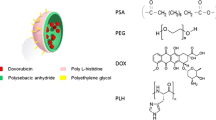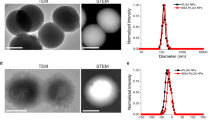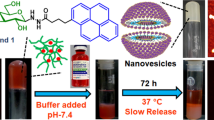Abstract
Purpose. To investigate some physicochemical properties of self-assembled hydrogel nanoparticles of pullulan acetate (PA) and sulfonamide conjugates, as a potential tumor targeting drug carrier responsive to tumor extracellular pH.
Methods. A new class of pH-responsive polymers was synthesized by conjugating a sulfonamide, sulfadimethoxine (SDM), to succinylated pullulan acetate (coohPA). The polymers formed self-assembled PA/SDM hydrogel nanoparticles in aqueous media, which was confirmed by fluorometry and field emission-scanning electron microscopy. The pH-dependent behavior of the nanoparticles was examined by measuring transmittance, particle size and zeta potential. Adriamycin (ADR) was tested for loading into and release from the nanoparticles at various pHs.
Results. The mean diameters of all PA/SDM nanoparticles tested were <70 nm, with a unimodal size distribution. The critical aggregation concentrations at pH 9.0 were as low as 3.16 μg/mL. The nanoparticles showed good stability at pH 7.4, but shrank and aggregated below pH 7.0. The ADR release rate from the PA/SDM nanoparticles was pH-dependent around physiological pH and significantly enhanced below a pH of 6.8.
Conclusions. The pH-responsive PA/SDM nanoparticles may provide some advantages for targeted anti-cancer drug delivery due to the particle aggregation and enhanced drug release rates at tumor pH.
Similar content being viewed by others
REFERENCES
H. Maeda, J. Wu, T. Sawa, Y. Matsumura, and K. Hori. Tumor vascular permeability and the EPR effect in macromolecular therapeutics: a review. J.Control.Release 65:271–284 (2000).
D. C. Drummond, O. Meyer, K. Hong, D. B. Kirpotin, and D. Papahadjopoulos. Optimizing liposomes for delivery of chemotherapeutic agent to solid tumors. Pharmacol.Rev. 51:691–743 (1999).
M. Yokoyama and T. Okano. Targetable drug carriers: present status and a future perspective. Adv.Drug Deliv.Rev. 21:77–80 (1996).
G. Kong, R. D. Braun, and M. W. Dewhirst. Characterization of the effect of hyperthermia on nanoparticle extravasation from tumor vasculature. Cancer Res. 61:3027–3032 (2001).
J. E. Chung, M. Yokoyama, and T. Okano. Inner core segment design for delivery control of thermo-responsive polymeric micelles. J.Control.Release 65:93–103 (2000).
S. Cammas, K. Suzuki, C. Sone, Y. Sakurai, K. Kataoka, and T. Okano. Thermo-responsive polymer nanoparticles with a coreshell micelle structure as site-specific drug carriers. J.Control.Release 48:157–164 (1997).
I. F. Tannock and D. Rotin. Acid pH in tumors and its potential for therapeutic exploitation. Cancer Res. 49:4373–4384 (1989).
M. Stubbs, P. M. J. McSheehy, J. R. Griffiths, and C. L. Bashford. Causes and consequences of tumor acidity and implications for treatment. Mol.Med.Today 6:15–19 (2000).
J. Conner, M. B. Yatvin, and L. Huang. pH-sensitive liposomes: Acid-induced liposomes fusion. Proc.Natl.Acad.Sci.USA 81:1715–1718 (1984).
M. Greidziak, A. A. Bogdanov, V. P. Torchilin, and J. Lasch. Destabilization of pH-sensitive liposomes in the presence of human erythrocyte ghosts. J.Control.Release 20:219–230 (1992).
J. C. Leroux, E. Roux, D. L. Garrec, K. Hong, and D. C. Drummond. N-isopropylacrylamide copolymers for the preparation of pH-sensitive liposomes and polymeric micelles. J.Control.Release 72:71–84 (2001).
D. C. Drummond, M. Zignani, and J. C. Leroux. Current status of pH-sensitive liposomes in drug delivery. Prog.in Lipid Res. 39:409–460 (2000).
M. Zignani, D. C. Drummond, O. Meyer, K. Hong, and J. C. Leroux. In vitro characterization of a novel polymeric-based pH-sensitive liposome system. Biochim.Biophys.Acta 1463:383–394 (2000).
O. Meyer, D. Papahadjopoulos, and J. C. Leroux. Copolymers of N-isopropylacrylamide can trigger pH sensitivity to stable liposomes. FEBS Lett. 421:61–64 (1998).
J. Tailefer, M. C. Jones, N. Brasser, J. E. van Lier, and J. C. Leroux. Preperation and characterization of pH-responsive polymeric micelles for the delivery of photosensitizing anticancer drugs. J.Pharm.Sci. 89:52–62 (2000).
K. Xi, Y. Tabata, K. Uno, M. Yoshimoto, T. Kishida, Y. Sokawa, and Y. Ikada. Liver targeting of interferon though pullulan conjugation. Pharm.Res. 13:1846–1850 (1996).
T. Nishikawa, K. Akiyoshi, and J. Sunamoto. Macromolecular complexation between bovine serum albumin and self-assembled hydrogel nanoparticle of hydrophobized polysaccharide. J.Am.Chem.Soc. 118:6110–6115 (1996).
E. E. Smissman. Sulfonamides and sulfones with antibacterial action. In C. O. Wilson, O. Gisvold, and R. F. Doerge (eds), Textbook of organic medicinal and pharmaceutical chemistry. J. B. Lippincott Co., Philadelphia, Pennsylvania, 1971 pp. 283–299.
S. Y. Park and Y. H. Bae. Novel pH-sensitive polymers containing sulfonamide groups. Macromol.Rapid Commun. 20:269–273 (1999).
M. Yokoyama. Novel passive targeting drug delivery with polymeric micelles. In T. Okano (ed.), Biorelated polymers and gels. Academic Press, Tokyo, 1998 pp. 193–229.
D. W. Urry, S. Q. Peng, T. M. Parker, D. C. Gowda, and R. D. Harris. Relative significance of electrostatic and hydrophobicinduced pKa shifts in a model protein: the aspartic acid residue. Angew.Chem.Int.Ed.Engl. 32:1440–1442 (1993).
Author information
Authors and Affiliations
Corresponding author
Rights and permissions
About this article
Cite this article
Na, K., Bae, Y.H. Self-Assembled Hydrogel Nanoparticles Responsive to Tumor Extracellular pH from Pullulan Derivative/Sulfonamide Conjugate: Characterization, Aggregation, and Adriamycin Release in Vitro . Pharm Res 19, 681–688 (2002). https://doi.org/10.1023/A:1015370532543
Issue Date:
DOI: https://doi.org/10.1023/A:1015370532543




